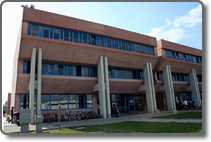

Department
of Mathematics and Computer Science
University of Udine
Carlo Drioli – Research activity
Physical modeling of the voice source
Low dimensional physically based glottal modeling
A low-complexity glottis model is proposed in which the lower edge of the folds is represented by a single mass-spring system and the propagation of the displacement is represented by a delay line of length T. The structure is a one-mass model with a propagation line aimed at simulating the propagation of the motion along the thickness of the fold. A second-order resonant filter represents the oscillating folds, an impact model reproduces the impact distortions on the fold displacement. The driving pressure Pm acting on the folds is computed from the flow and the fold displacement using Bernoulli’s law. A flow model converts the glottis area given by the fold displacement into the airflow at the entrance of the vocal tract. The glottis area is computed as the the minimum cross-sectional area between the areas at lower and the upper vocal fold edge, and the flow is assumed proportional to the glottal area. The propagation line is an approximation of the vocal cord along the thickness (vertical) direction and reproduces the vertical phase difference of the vibration of the cord edges, and it is an essential element for the production of self-sustained oscillations without a vocal tract load.
Audio Examples ( formant filter driven by the glottal source )
|
Modal voice Wav |
Breathy voice Wav |
Pitch control Wav |
Onset threshold Wav |
References
Carlo Drioli. A flow waveform adaptive mechanical glottal model. in TMH-QPSR Vol. 43, pp. 69-79, 2002. [pdf]
Carlo Drioli, “A flow waveform matched low-dimensional glottal model based on physical knowledge”, in The Journal of the Acoustical Society of America, vol. 117, n. 5, pp. 3184-3195, 2005.
Low dimensional physically based glottal modeling with waveform matching properties
We investigated a class of source models which combine physical knowledge and data driven parametric fitting to the aim of reproducing inverse filtered glottal flow waveforms. We introduce a waveform-matched mathematical model of the glottis loosely inspired to the myoelastic-aerodynamic theory and the lumped mass-spring paradigm. The principal difference with respect to traditional one- and multi-mass models is the oversimplification of the mechanical resonator and the inclusion of a parametric nonlinear component in the mechano aerodynamic loop. The design of this component relies on an data-driven identification scheme which allows the model oscillation to be fitted to a target volume velocity waveform.
References
Carlo Drioli, “A flow waveform matched low-dimensional glottal model based on physical knowledge”, in The Journal of the Acoustical Society of America, vol. 117, n. 5, pp. 3184-3195, 2005.